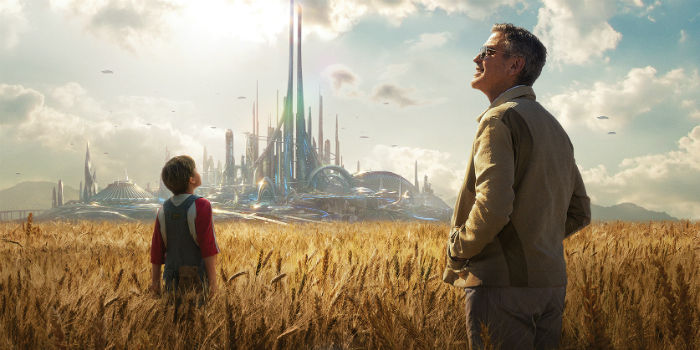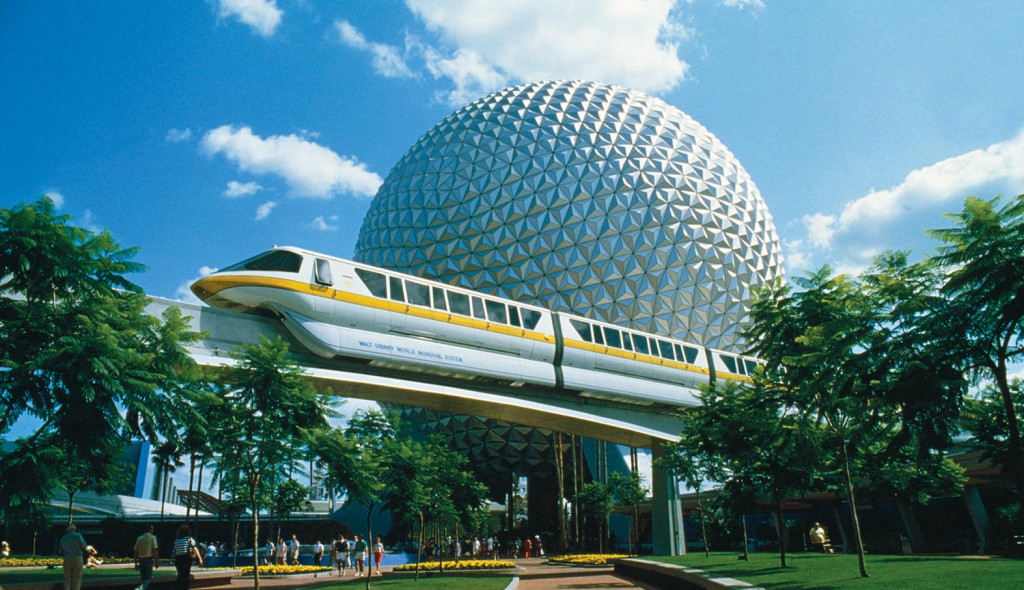“They Repackaged It”: Technofuturism in Tomorrowland

Post by Li Cornfeld, McGill University
In an early action sequence of Tomorrowland, the new fantasy film from Disney, quirky proprietors of a Texas junk shop called Blast From the Past open fire with technologies of the future. The shopkeepers Ursula Gernsback (Kathryn Hahn) and Hugo Gernsback (Keegan-Michael Key) wield glowing guns whose candy colored sparks rip through the ceiling; defeated, their bodies spontaneously combust. The murderous merchants were “AA units,” or “audio-animatronics,” explains a mysterious young girl called Athena (Raffey Cassidy), moments after rescuing their intended victim (Britt Robertson) from the blast. Then she twists a screwdriver into a blue port on her own shoulder; Athena, too, is a robot. Futuristic technology might destroy the world, warns Tomorrowland, but it can also save it. In a return to Disney’s mid-century technofuturism, the movie implores audiences to choose optimism.
Tomorrowland’s resident optimist, a variant of Dorothy in Oz, is neither a good robot nor a bad robot; she’s Casey Newton, from Florida. With the help of Athena, and Athena’s old pal Frank, a jaded recluse played by George Clooney, Casey (Robertson) journeys to the otherworldly Tomorrowland, an alternate dimension colonized by an elite group of humans during the last century to foster accelerated advances in science and technology. Decades ago, for example, Tomorrowland discovered particles that permit a voyeuristic form of time travel; Hugh Laurie’s villainous Governor Nix sneers that on Earth, “physicists are still arguing over whether or not they exist.” A chance to glimpse technology of an immanent future, of course, was the promise of the original Tomorrowland, Disneyland’s futurist region from which the movie takes its name.

When the first Tomorrowland opened in 1955, its signature attraction, the TWA Moonliner, promoted the future by inviting tourists to participate in an imagined moon landing. (The Tomorrowland movie signals its investment in this midcentury vision of the future when it frames the dismantling of a NASA launching pad as the end of futurity.) A decade later, Tomorrowland acquired The General Electric Carousel of Progress, a 1964 World’s Fair attraction that took audiences on a tour of domestic life throughout the 20th century, culminating in a future of ease and leisure afforded by technological development. The Tomorrowland movie, whose earliest scenes take place at the 1964 World’s Fair, sets the atmosphere with the Carousel of Progress theme song, There’s a Great Big Beautiful Tomorrow. Songwriters Robert and Richard Sherman, in a lovingly compiled memoir, recall that they wrote the song about Walt Disney himself, whom they describe as “an optimistic futurist,” dedicated to building a future that was “great, big, and beautiful.”
Tomorrowland bemoans the loss of that vision. Director Brad Bird, who co-wrote the script with Damon Lindelof, avoids self-conscious corporate references, and so while the mythologized spirit of Walt Disney pervades the movie, the man himself goes unmentioned. (“Audio-animatronics,” a Disney coinage, is perhaps oblique enough a reference to warrant inclusion.) When Frank speaks wistfully of his 1960’s childhood, before the future became “scary,” and when Nix charges that the people of earth “didn’t fear their demise—they repackaged it,” Bird surely intends to level the critique at what he perceives as a global culture of fear and resignation. Still, bracketing dubious nostalgia for the Cold War as an era without a politics of fear, we might consider how Disney’s own corporate history indexes a departure from space age optimism.

Disney expanded its investment in fantasy futuristic landscapes with the launch of EPCOT, a theme park adjacent to Orlando’s Magic Kingdom, in 1982. Modeled on the industrial futurism of a world’s fair, and centered around a domed “Spaceship Earth” that showcases communications technology “from the stone age to the information age,” EPCOT celebrated the same technofuturism that girded the development of the original Tomorrowland. Yet this second Orlando theme park also crystalized Disney’s abandonment of its earlier, ambitious vision: the Experimental Prototype Community of Tomorrow was originally conceived as an industrial-residential community that would revolutionize America. (The futurist settlement of the Tomorrowland movie, with its gleaming central tower and elevated transportation systems, takes its design cues from the original EPCOT plans.) Opening EPCOT as a theme park, Disney committed itself to the creation of fantasy futures rather than to their realization. (“It’s hard to have ideas and easy to give up,” laments Tomorrowland.)
By the mid-1990’s, Disney reversed its orientation to the future altogether: it reinvented Tomorrowland as “the future that never was,” a retro-futurist celebration of historical visions of “tomorrow” that failed to emerge. In an editorial that deemed the change “profound for a company whose founder was one of postwar America’s great popularizers of technology,” the New York Times worried that “as technology has entered lives, it has departed from many imaginations.” Curiously, the Tomorrowland movie likewise fails to fully imagine its own technofuturism. For all its exhortations to picture a better future, the movie never reveals much of what’s behind Tomorrowland’s shiny façade. Its most developed conception of Tomorrowland’s technological capabilities – also its most playful – are the audio-animatronic robots who make their way to Earth.
Audio-animatronics, too, have a long Disney history. Disney engineers began experimenting with lifelike robots in the mid-1940s, and by 1955, audio-animatronic animals populated Disneyland. Humanoid audio-animatronics made their debut at the 1964 World’s Fair, where Disney assured fairgoers “a final result so lifelike that you might find it hard to believe.” Even Disney detractor Richard Schickel would remark on the “astonishing fidelity” of the Fair’s audio-animatronic Abraham Lincoln. Today, Disney promotional copy touts its remaining World’s Fair audio-animatronics as employing “Disney’s latest animation technology of the time,” an indication that, following the company’s midcentury robotic enthusiasm, audio-animatronics garnered little further attention—at least, until this summer’s release of Tomorrowland. When the movie pins its optimism on the development of fresh units of AA’s who will revitalize Tomorrowland, Disney casts its newest vision of the future in the mold of its own past.


